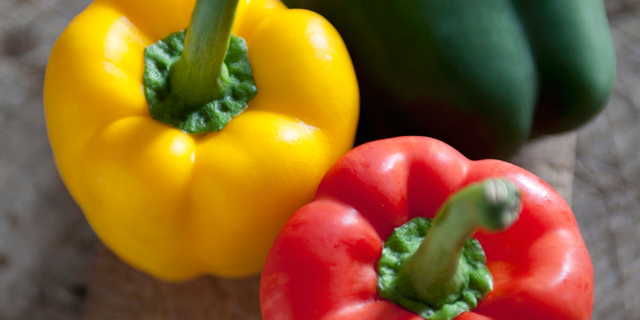Bell peppers may be your favorite vegetable, but they are
technically a fruit! Another fun fact about this Latin kitchen staple is that
their crisp crunch and sweet taste is only rivaled by their nutritional
richness. Bell peppers are an antioxidant powerhouse, with more Vitamin C per
cup than an orange! They are also a good source of Vitamin E, Vitamin A, and
Vitamin B. With over 2 grams of fiber and 1 gram of protein per 40 calorie cup,
it’s not wonder they are so popular!
How
do I pick the best bell peppers?
Bell peppers come in a variety of shapes, sizes, and colors. Most bell peppers start out as some shade of green then change
color on the vine as they ripen. Varying shades of white,
yellow, orange, red, purple, and green are common and delicious. The brighter
the pepper, yellow, orange and red, the sweeter the taste. Purple peppers tend
to be a bit bitter but are equally as scrumptious.
No matter the color, look for peppers that
are firm and crisp. Since peppers comes in a variety of shapes and sizes,
ensure that the pepper feels heavy for its particular size. The color,
regardless of shade, should be deep and vivid and stems should look bright and
fresh. Avoid any peppers that have wrinkled skin, soft spots, or blemishes.
Remember, a fresh, ripe bell pepper will
provide the greatest nutritional benefits so choose wisely.
What
can I make with bell peppers?
Bell peppers are often enjoyed raw, roasted,
grilled, and sautéed,
though you can bake, braise, and broil them too! Use roasted red bell peppers in a spicy paprika hummus,
stuff yellow peppers with quinoa, and use sliced green peppers in a fresh salad.
Add chopped peppers to your morning scrambled eggs, layer pickled peppers in
your lunch sandwich, or grill to top off your dinner fajitas.
To prep bell peppers, first rinse under cold water. Using a
paring knife, cut wide slices top to bottom around the stem. You’ll
be left with all of the sides of the pepper and the bottom. Discard stem, core, and seeds, then slice and dice as needed. For stuffed peppers use a paring
knife to cut around the stem and remove the core, then fill, bake, and enjoy!
Raw bell peppers will remain fresh in your crisper for up to 10 days. For longer storage consider freezing
peppers. Place rinsed and dried whole peppers, or pepper slices, in a freezer
safe zip lock with all excess air removed. Frozen in this manner, peppers will
remain fresh for up to one year. Use frozen peppers in sautés, soups, or stews!
Recipes to try include: Marinated Veggie Sandwich, Wild Rice Salad with Lemon Pepper Chicken, and Roasted Red Peppers Stuffed with Power Quinoa Salad.


![Making Mealtime Matter with La Familia: Easy Sofrito [Video]](https://thelatinkitchen.com/wp-content/uploads/2015/10/sofrito-shutterstock__0-500x383.jpg)
![Easy Latin Smoothies: Goji Berry Smoothie [Video]](https://thelatinkitchen.com/wp-content/uploads/2015/12/goji_berry-shutterstock_-500x383.jpg)
















![Fun and Fast Recipes: Fiesta Cabbage Salad [Video]](https://thelatinkitchen.com/wp-content/uploads/2015/11/fiesta_cabbage_slaw-shutterstock_-500x383.jpg)









